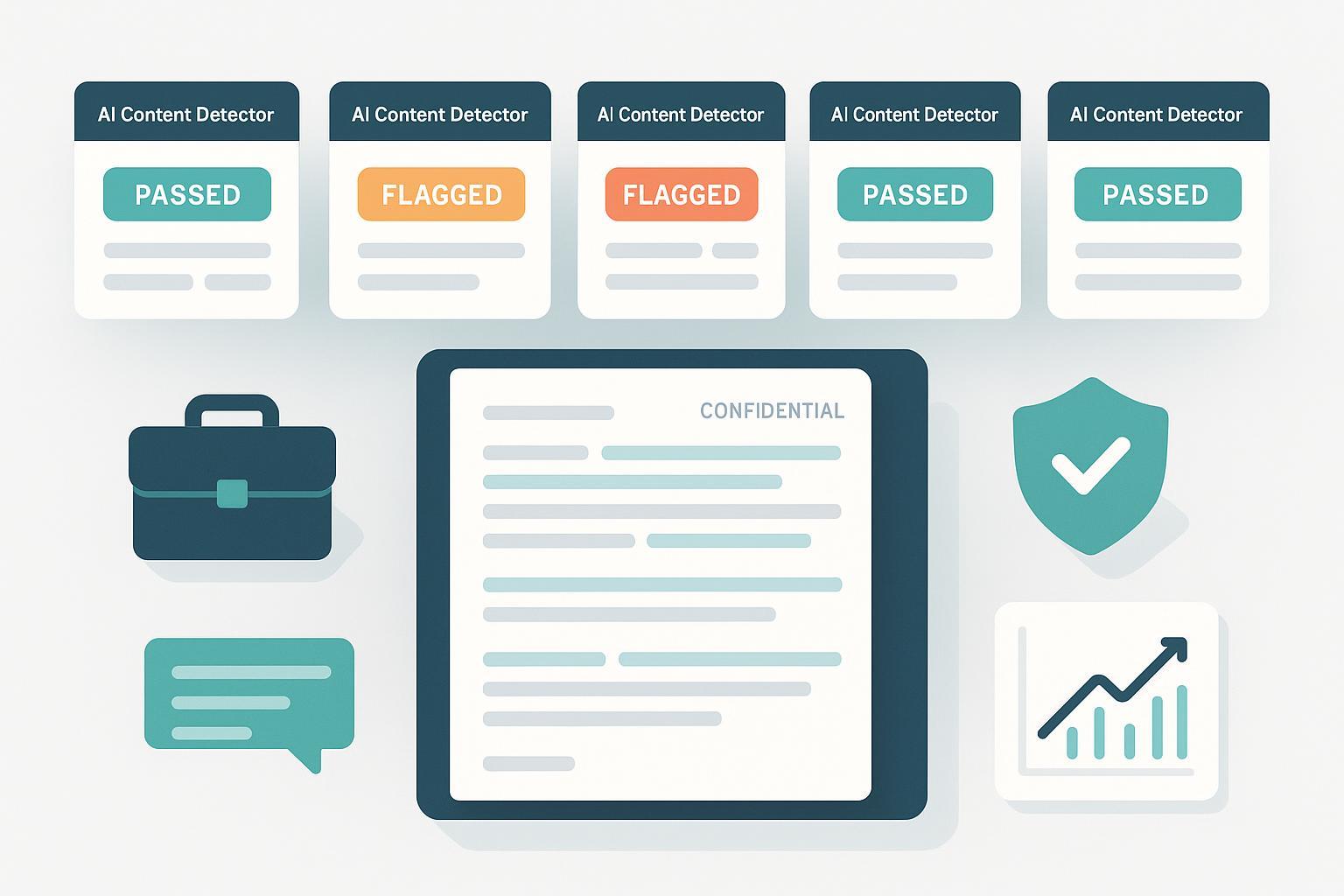How AI Content Detectors Fail on Human‑Edited AI Text in Corporate Communications (2025)

Corporate communications teams increasingly rely on AI to draft memos, policy updates, executive letters, and press materials—often followed by human editing. That hybrid workflow exposes a blind spot: today’s AI content detectors are far less reliable once text has been paraphrased, revised, or collaboratively edited. In high‑stakes environments, that can mean both false negatives (AI‑assisted text passing as “human”) and false positives (legitimate human writing erroneously flagged), each with reputational and compliance risk.
This comparison takes a practical, enterprise lens to five commonly used detectors—GPTZero, Originality.ai, Copyleaks, Turnitin’s AI writing detection, and Writer’s AI Content Detector status—focusing on where and why they struggle with human‑edited AI and what corporate teams can do instead of (or in addition to) detection-only approaches.
Why detectors miss human‑edited AI
Most detectors analyze statistical signals of “machine‑likeness,” such as perplexity/burstiness patterns or model‑trained classifiers. When humans paraphrase, restructure, or blend passages, those signals often weaken. The U.S. National Institute of Standards and Technology notes in its 2024 guidance that detection improves when provenance signals (watermarks, signatures) exist, but paraphrasing or downstream editing can strip or distort those signals, making origin classification unreliable; see the 2024 interim guidance in the NIST Synthetic Content series, summarized in the official draft, the Reducing Risks Posed by Synthetic Content IPD. For broader governance context, NIST’s AI Risk Management Framework (2023–2024) encourages layered, organizational controls rather than single‑point tools.
We’ve been here before: OpenAI discontinued its AI Text Classifier in 2023, citing significant limitations such as low accuracy and bias, which underscores the broader challenge of origin detection for text as models and editing tools evolve.
Operationally, the gaps tend to appear in:
- Human‑edited or paraphrased AI copy (false negatives rise)
- Highly formal, technical, or non‑native English writing (false positives can rise)
- Short corporate snippets and mixed‑source documents (proportion estimates are noisy)
Illustratively, a 2024‑summarized evaluation cited by Illinois State University’s academic development office reported that paraphrasing reduced detector accuracy by roughly half and noted non‑trivial false positive rates on human text, reinforcing that these tools are best for triage with human review rather than adjudication at high stakes.
What this means for corporate teams
- False negatives create authenticity risk: AI‑assisted passages may appear “clean,” undermining policies that require disclosure or human review.
- False positives create fairness and legal risk: accusing a human author of using AI can damage morale and trust if not defensible.
- Mixed content is hard to score: many tools struggle to quantify “how much” of a document is AI‑generated versus human.
The practical takeaway: treat detectors as triage tools that surface items for review. Do not use a single detector score to make employment, disciplinary, legal, or customer‑facing decisions.
The tools, compared by scenarios (2025)
Ordering within each scenario is alphabetical. We avoid declaring a single “winner” because the best choice depends on your risk posture, integration needs, and review workflows.
Scenario 1: Quick triage and educational workflows
- Copyleaks — Strengths: strong vendor posture on education and enterprise APIs; straightforward credit model (approx. 250 words per credit) and usage transparency. Limitations: like peers, degrades on heavily paraphrased/edited text; published accuracy claims vary by context. Fit: initial screening in large content batches; pair with human review.
- GPTZero — Strengths: vendor publishes benchmarking and emphasizes low false positives in stated conditions (e.g., “~0.9%” in its own tests). Limitations: detection quality drops on paraphrased and human‑edited text, and on short snippets. Fit: fast classroom/department triage; use conservative thresholds and review.
- Originality.ai — Strengths: multiple modes (AI, plagiarism) and API support; vendor‑run studies report high accuracy on clean AI outputs. Limitations: independent testing shows degradation on edited or formal/non‑native text; tune thresholds to reduce over‑flagging. Fit: batch screening with API; requires policy guardrails.
- Turnitin (AI writing detection) — Strengths: deeply integrated in LMS environments; crucially frames results as probabilistic indicators. Limitations: not built for individual purchase; institutional licensing only; low scores displayed with caution to avoid false positives. Fit: academic/corporate training contexts where probabilistic interpretation is understood.
Scenario 2: Low false‑positive posture (policy‑sensitive environments)
- Copyleaks — Enterprise controls and documentation make it configurable; still, expect false positives on certain formal styles—set conservative policies and require human sign‑off.
- GPTZero — Public benchmarking provides some transparency; use higher confidence thresholds and avoid acting on borderline scores.
- Originality.ai — Offers tunable settings and API routing; calibrate for recall vs. precision trade‑offs and log evidence for audit.
- Turnitin — Explicit probabilistic framing and low‑score display behavior (no highlights for 1%–19%) are helpful for reducing over‑reliance on weak signals.
Scenario 3: API/integration‑heavy workflows
- Copyleaks — Mature API, enterprise analytics, and compliance posture (e.g., GDPR, SOC). Useful for centralizing scan logs in content pipelines.
- Originality.ai — Developer‑friendly API and credit model for embedding checks into CMS or review gates.
- Turnitin — Best fit where LMS/education stack is core; for corporate use, requires institutional arrangements.
Note on Writer: Several third‑party lists still reference “Writer’s AI Content Detector,” but Writer’s official materials emphasize generation, claims, and governance features rather than a standalone AI‑vs‑human origin detector. Treat any such detector references as legacy or context‑dependent.
Vendor summaries with official guidance and limits
- GPTZero: The vendor’s benchmarking materials emphasize high accuracy on clean AI text and low false positives in their tests, but results should be interpreted conservatively on edited content. See GPTZero’s own AI Accuracy Benchmarking page (2024–2025 context) for details.
- Originality.ai: Vendor‑run studies cite high accuracy across several models; however, independent evaluations show detectors—including Originality.ai—degrade on paraphrased and human‑edited content. See the Originality.ai RAID study for methodology and caveats.
- Copyleaks: Education‑oriented but enterprise‑capable detector with an explicit credit model and active release notes. Performance varies by text type; expect reduced detection on paraphrased/human‑edited text.
- Turnitin: Designed and communicated as a probabilistic indicator integrated into Similarity Reports; low ranges are deliberately deemphasized to reduce false positives. Turnitin does not sell individual licenses; use within an institutional agreement.
- Writer: As of 2024–2025 public materials, Writer focuses on enterprise AI content creation and compliance features; no current official page for a standalone AI content detector was found.
What detectors can and cannot decide
- Can: flag likely AI‑assisted passages for editorial attention; provide a consistent triage signal; help educate teams about risky patterns.
- Cannot: prove authorship, establish intent, or sustain disciplinary/legal actions on their own. Treat scores as one input among many. For high‑stakes matters, require human review, documented evidence, and due process.
Building layered controls beyond detection
- Author attestations and controlled writing environments (e.g., declare AI use; restrict unlogged drafting tools for regulated content).
- Version control and edit‑history retention so reviewers can inspect how text evolved.
- Provenance signals where available (watermarks/metadata), recognizing that downstream paraphrasing can erode them.
- Editorial checkpoints proportionate to risk (executive letters, policy updates, financial or ESG disclosures get enhanced review).
- Brand and reputation monitoring across AI answer engines to see how your content is summarized and perceived—complementary to origin detection.
For teams exploring non‑detection complements such as search visibility and reputation oversight, see introductions to Generative Engine Optimization (GEO) and AI search visibility monitoring on the Geneo homepage and the Geneo blog for deeper tactics. For a concrete example of cross‑engine brand/result tracking in 2025, review this Geneo query report on GDPR fine coverage patterns.
Also consider (related alternative for governance)
- Geneo — An AI search visibility and sentiment monitoring platform for tracking brand mentions and tone across ChatGPT, Perplexity, and Google AI Overviews; relevant when you want to oversee how your brand and official narratives are represented in AI answers over time. Disclosure: Geneo is our product.
Practical recommendations for 2025
- Use detectors for triage, not verdicts. Pair scores with human review and maintain an audit trail.
- Calibrate thresholds by document type. For formal policy or non‑native English content, set conservative interpretations to avoid over‑flagging.
- Plan for edited and hybrid content. Assume paraphrased AI will evade detection; invest in process controls (attestations, edit histories) to manage risk.
- Centralize logs. Whether via APIs or exports, keep consistent records for defensibility and continuous improvement.
- Monitor reputation externally. Watch how AI answer engines present your brand and key positions; adjust communications and disclosures accordingly.
Cited official resources and advisories (selected)
- NIST (2024) on synthetic content and provenance limitations: Reducing Risks Posed by Synthetic Content (interim draft).
- OpenAI (2023) on discontinuing the AI Text Classifier due to low accuracy and bias concerns.
- GPTZero (2024–2025) AI Accuracy Benchmarking and methodology guidance.
- Originality.ai (2024–2025) RAID and scholarly publication studies on detector performance.
- Copyleaks (2024–2025) credit model and release notes indicating active product development.
- Turnitin (2024–2025) official guides on AI writing detection and probabilistic interpretation.
- Illinois State University (2024 summary) noting substantial accuracy degradation after paraphrasing and meaningful false positives on human text.
External links referenced inline above:
- NIST Synthetic Content IPD (2024): https://airc.nist.gov/docs/NIST.AI.100-4.SyntheticContent.ipd.pdf
- OpenAI AI Text Classifier discontinued (2023): https://help.openai.com/en/articles/6825453-ai-text-classifier
- GPTZero AI Accuracy Benchmarking: https://gptzero.me/news/ai-accuracy-benchmarking/
- Originality.ai RAID study: https://originality.ai/blog/robust-ai-detection-study-raid
- Copyleaks release notes and credit model refs: https://docs.copyleaks.com/resources/updates/release-notes/ and https://help.copyleaks.com/s/article/HowdoIcheckhowmanycreditsmyscanwillcost6813c2c1093d8
- Turnitin AI writing detection (Enhanced Similarity Report): https://guides.turnitin.com/hc/en-us/articles/22774058814093-AI-writing-detection-in-the-new-enhanced-Similarity-Report
- Illinois State University detector limitations summary: https://prodev.illinoisstate.edu/ai/detectors/
[Internal links]
- Geneo homepage: https://geneo.app
- Geneo blog: https://geneo.app/blog/
- Geneo query report example (GDPR fines): https://geneo.app/query-reports/gdpr-fines-2025-largest-cases

